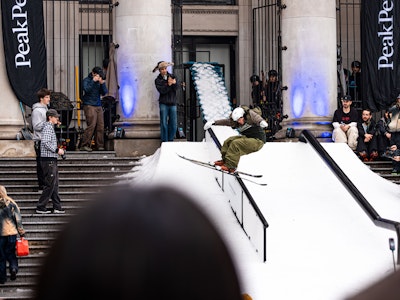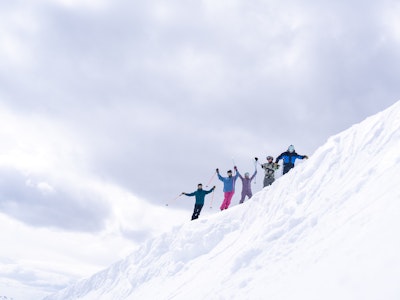In Ischgl, Austria, you’ll find a steep and deep freeride oasis disguised as an inexhaustible party town.
WORDS • DONNY O’NEILL
The final rays of late-winter sunshine crowned the forested caps of the foothills above me. I zipped up my puffy jacket and wrapped the hood around my head as the shadows dropped the temperature to shiver levels. I was groggy and jet-lagged following a 15-hour travel day that deposited me here, in Ischgl, Austria, where I strolled to the local market for a snack.
I walked leisurely up the street, focusing on my first glimpses of Ischgl through weary eyes. The Pardatschgratbahn, a gargantuan cable car structure that serves as an entry point to the Silvretta Arena, towered above, its cables rising 1,251 meters into the sky and out of sight. It was 4 p.m., but the rhythmic thumping of dance music, the clang of beer mugs and the raucous bellows of delight piercing my ears conveyed a much later time of night. All around me, it seemed, the après ski scene was reaching levels I had only witnessed on rare occasions back home in the States.
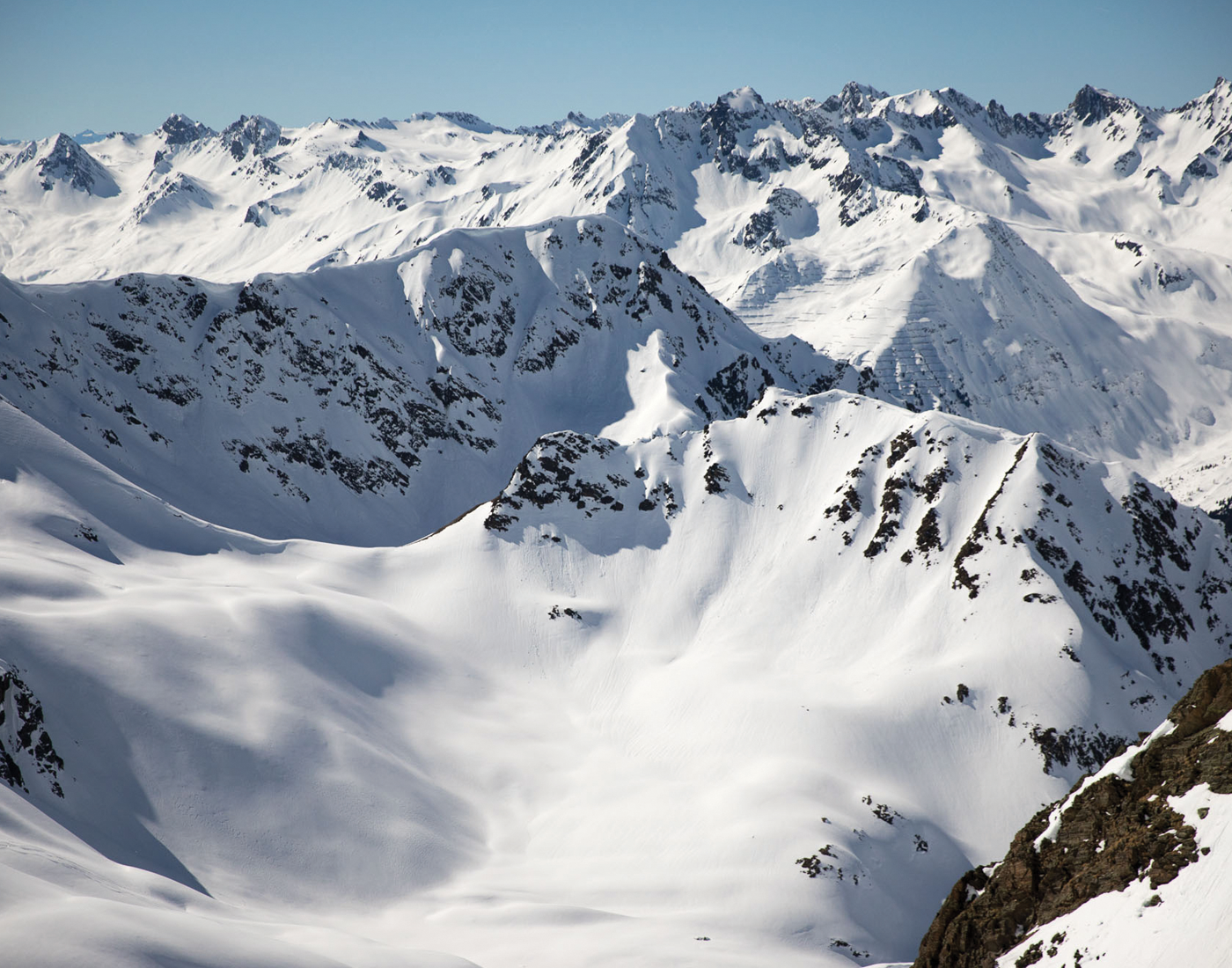
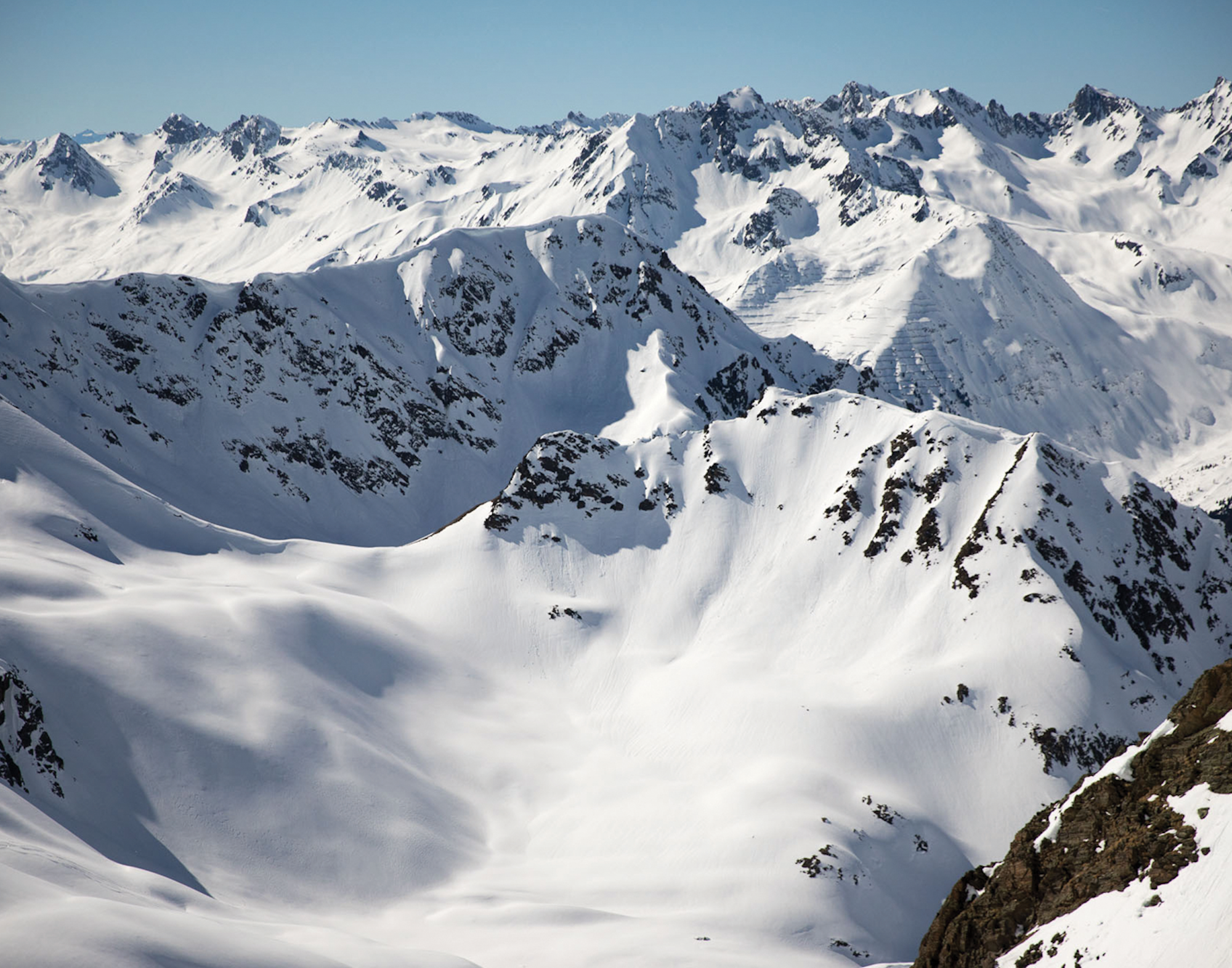
Vast territory in the Austrian Alps. | PHOTO: Ethan Stone
Instead of feasting on the visual meal provided by the picturesque Tyrol region, my attention was squarely on the partying at designated après ski bars like the Wedl Alm, Nikis Stadl, Kitzloch and Hotel Nevada. People were raging, everywhere.
As a newcomer to the Alps, I had always pictured the scene here as quaint and old-fashioned, reflecting the serious alpinist spirit I had always associated with skiing in the 3,000-meter peaks of this region. On the drive into town, the picture in my head was affirmed, as we passed countless green pastures and local farms nestled in the shadows of mountains that dominated the skyline, before settling into the old-timey Hotel Ischgl. I wasn’t expecting to encounter Austrian and German spring breakers saturated into a stupor and stomping in unison with Euro-dance beats in the late afternoon. I felt like a naïve American who hadn’t done his homework. An ABBA club remix blended with my jet lag and made my head spin. It turns out, Ischgl is known for its party scene, but I’d soon find if you put in a bit of effort, the quality of skiing would far outweigh the quantity of spring break debauchery.
The next morning, Ischgl was bustling as I hopped in line at the eight-person Fimbabahn gondola with photographer Ethan Stone and members of the Fischer Skis crew in town for a team athlete summit. All around us were vacationing skiers, many of whom donned outfits that seemed to be inspired by the disco era—bright, reflective and glittery. I pulled on my goggles to shield my eyes from the glare. It was 8:30 a.m., and the gaggle of people in the gondola line were up and at ‘em, showing no signs of fatigue from the party scene I had witnessed the evening prior. It seemed skiing was still the main attraction around here.
Down in the valley, the spring thaw was in full effect, and a layer of emerald green crept to the top of the foothills, before giving way to the thick cape of white worn by the high-alpine peaks and plateaus. Our expectations were tempered, given the balmy spring temperatures and lack of recent snow, but we were on the way to meet our mountain guide for the next few days, and were optimistic he could lead us to the goods. From everyone I’d talked to, it’s almost imperative to hire a guide for a first-time visit to the Alps; the connected ski areas are so expansive and lack boundary lines, making it easy to get lost and spend more time navigating than skiing the best terrain and snow.
Traveling the 950 meters to the top of the gondola was like riding a spaceship to another planet. The sheer relief between the valley at 1,360 meters and mid-mountain, at 2,231 meters, revealed a wild contrast in climate, and a vast, undulating sea of white greeted us when we emerged from the gondola station. We met our guide, Robert, near the ski school. We were 10 minutes late—the logistical scramble of grabbing lift tickets and maneuvering through the gondola maze put us at the designated meeting point past the agreed upon 9 a.m. Adhering to the Austrian requisite of promptness, Robert was visibly miffed at our tardiness, and didn’t tolerate any more dawdling as he checked our beacons and ushered us to the lift and up another 450 meters in elevation.
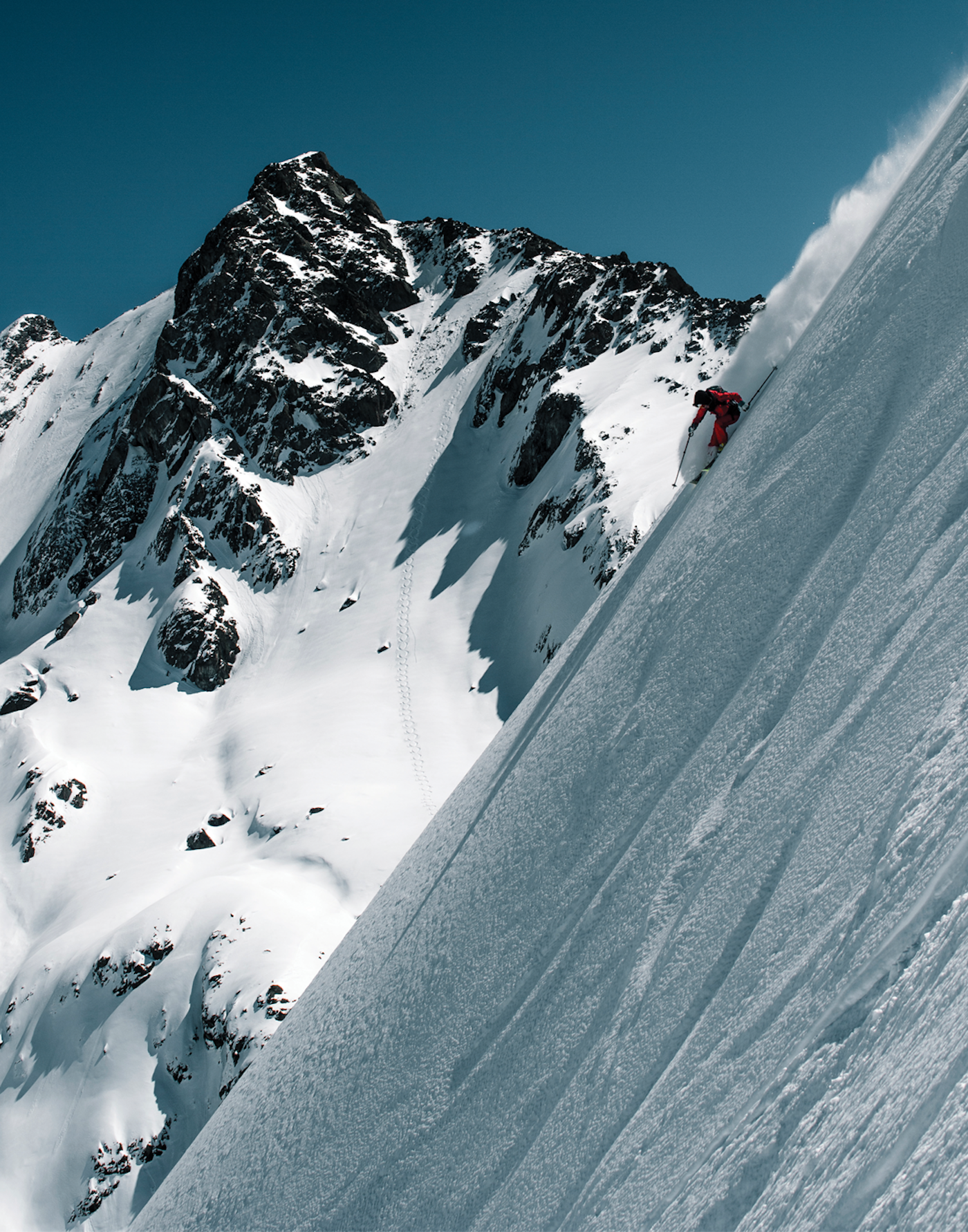
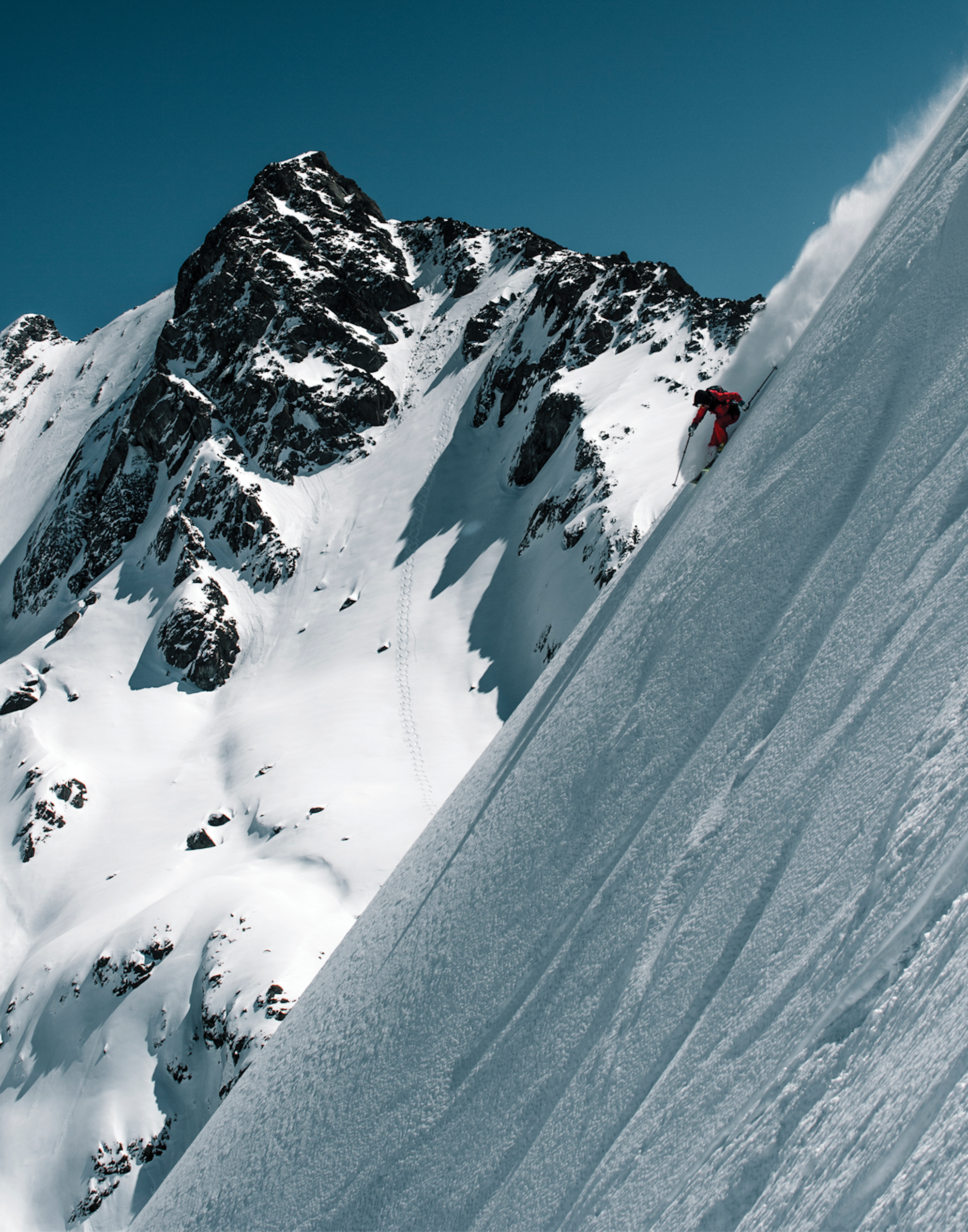
SKIER: Lynsey Dyer | PHOTO: Adam Klingeteg
Like a track runner shooting off the starting blocks, Robert skied off the lift in a rush, shimmied up a snowbank on the side of the run and turned to make sure we were following.
“Quick traverse,” he assured us in his broken English.
We followed his lead, skating, sidestepping and shuffling for five minutes before ending up atop a small garden of pristine powder, preserved by the shadow of a rounded peak to our left. Well, that was easy. Robert looked pleased, and I understood there was a reason he expected a prompt arrival to begin our day.
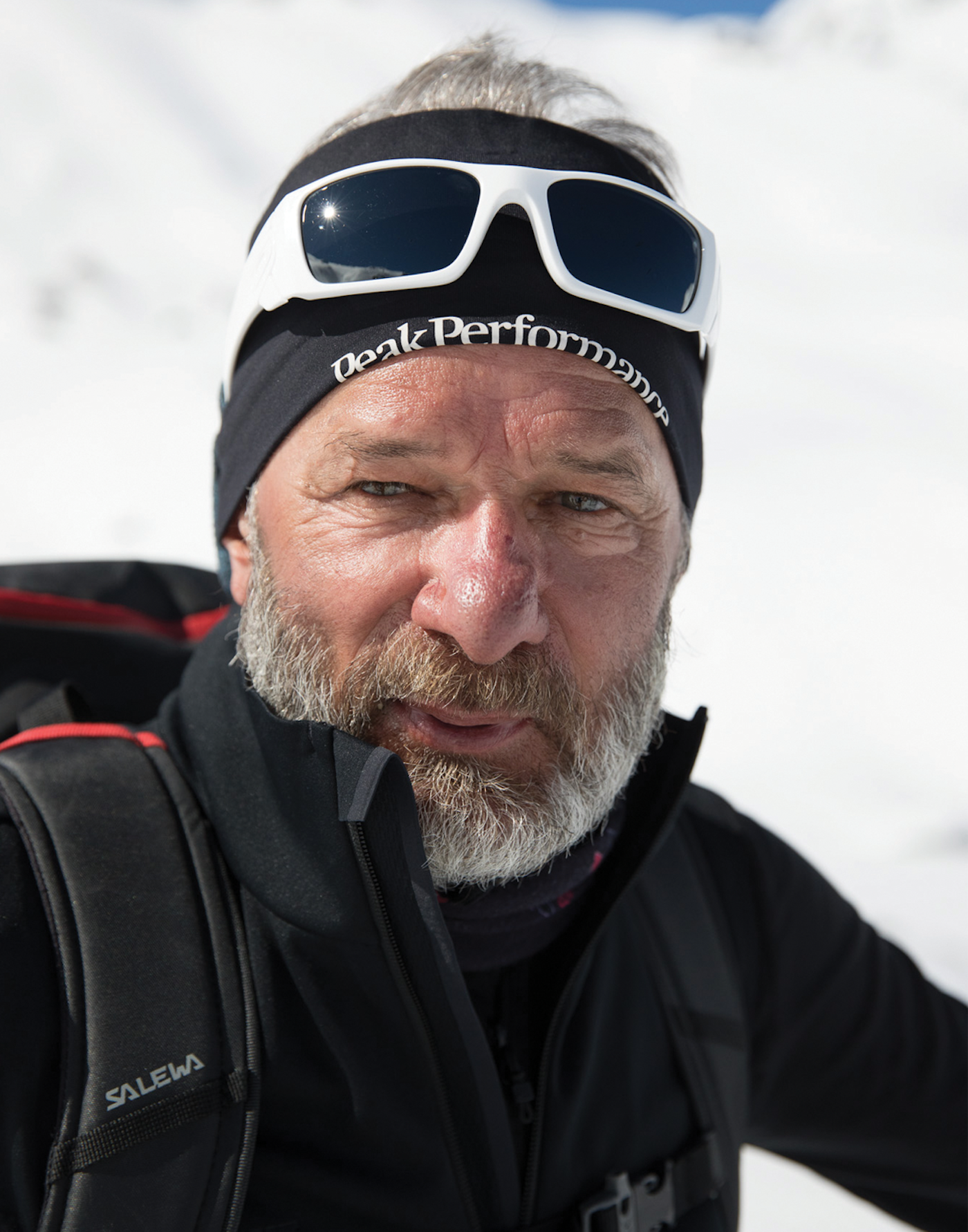
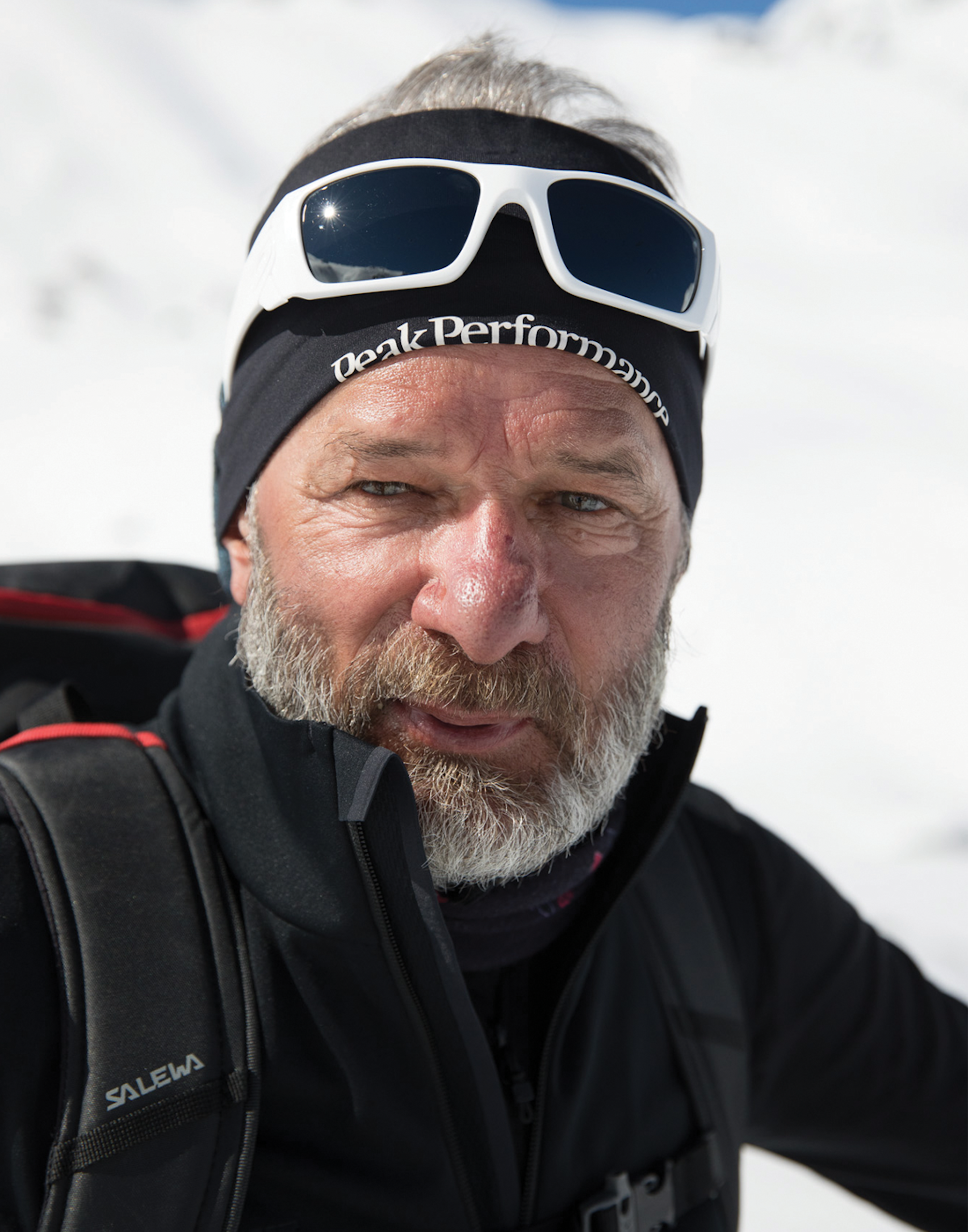
Robert was a well-built man in his 50s who sported a thick beard of white across a sun-weathered face and donned a simple pairing of sunglasses and a white headband for protection. He’d spent his whole life living in this Austrian valley and I’d find out in the following days, through brief conversations struggling to pierce our language barrier, that he lived to ski. At one juncture, he pointed up to a prismatic summit with a meandering bootpack up its flank, and a serpentine trench falling down and out of sight. Then, he pointed at himself.
“That was you?” I asked.
He nodded, a smirk on his face. His life revolved around skiing, but even more so, he lived to share the magnificence of his home with visitors through his job as a ski guide. After he sized us up on that first pitch, and understood that we sought untouched powder, he formulated a game plan that would vastly exceed our formerly tempered expectations.
“Robert was down for anything and glad to get into zones where he usually doesn’t take clients,” said Stone, an American ex-pat living in Switzerland whose fluency in German helped our communication efforts tremendously.
On our next lap, we climbed a quick bootpack to a series of chutes—once again untouched—that funneled us into an open bowl of creamy snow softened up by the late-March sunshine. Before he led us back into a hidden powder zone, Robert thought it appropriate to make a detour across the border and into Switzerland. One by one, he led us through a couloir that he explained was previously a smuggler route after World War II, used to transport meat, butter, cheese, fur and leather to Switzerland, and bring tobacco, coffee and spices back over to Austria. The rock tube in the mountain’s wall was filled with stale blocks of avalanche debris, where each hop-turn required supreme focus and balance. He wanted to show us Switzerland, yes, but he was also testing our abilities before upping the ante on our next run.
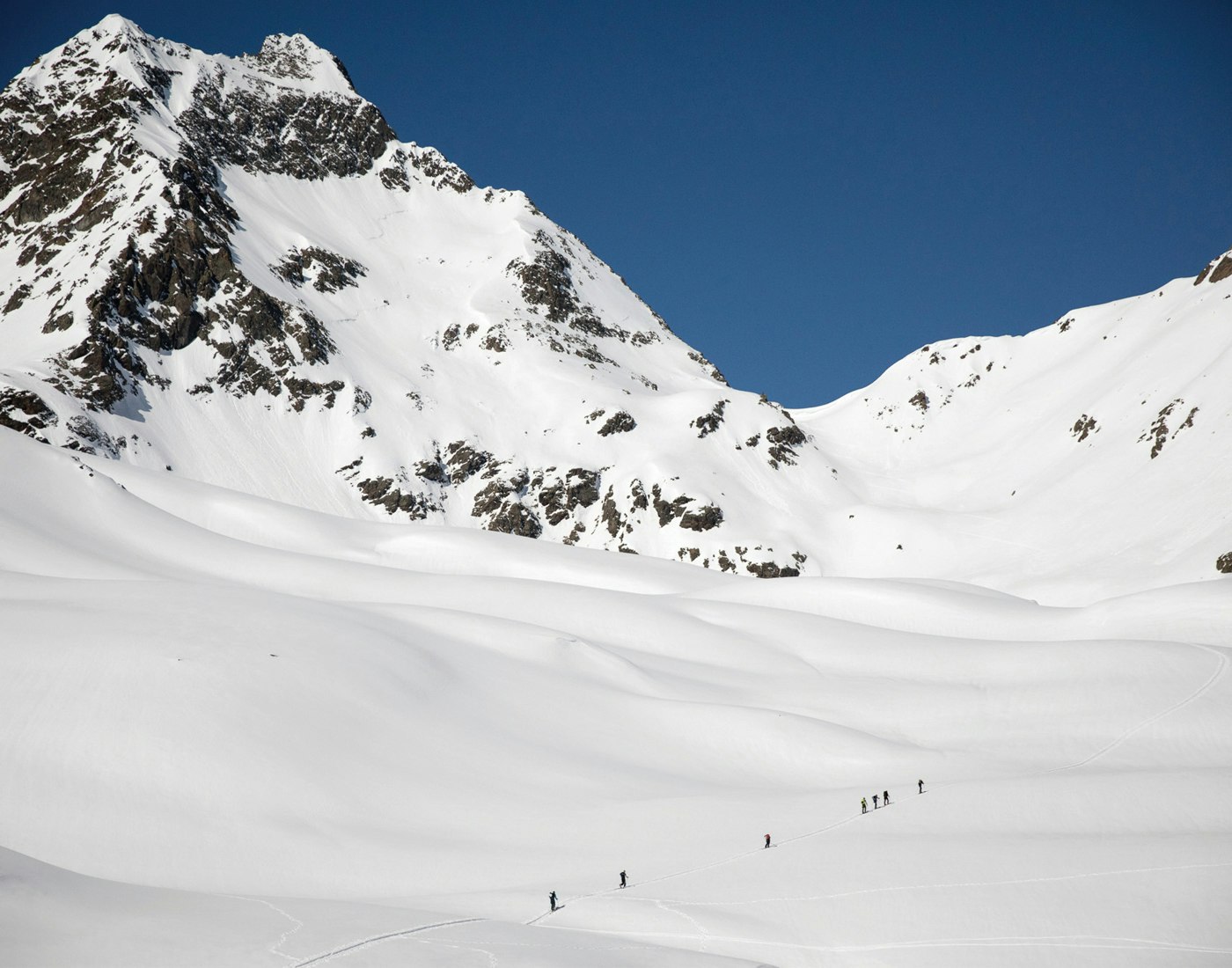
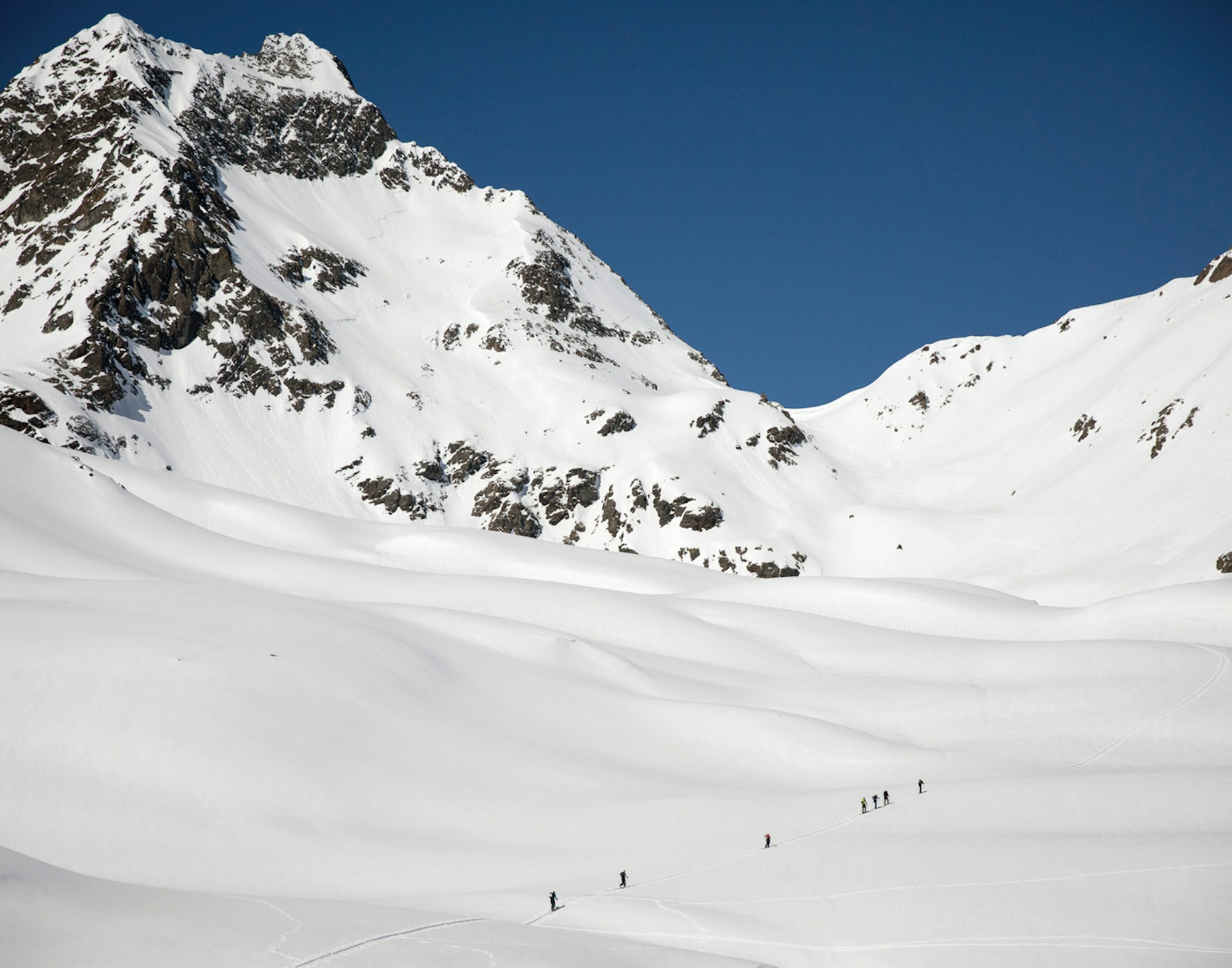
Ants go marching amongst the giants of the Alps. | PHOTO: Ethan Stone
The mountain spit us out across the Swiss border, in the town of Samnaun, where we hitched a ride on an impressive double-decker aerial tram back over the border and onto the summit plateau.
“By the time we finished the leg-burning descent in old avalanche debris over to the Swiss side of the resort, we realized we’d definitely get our money’s worth, not to mention a workout, skiing with Robert,” said Stone.
We passed Robert’s test, and it was open season after that. Never hiking or traversing more than ten minutes at a time, we spent the next two days ticking off immaculate descent after immaculate descent. Like a skier’s North Star, Robert guided us into the shadows, his route-finding perfected after a lifetime skiing here, where nooks in the rock were flooded with unspoiled cold-smoke snow.
At one point, I stood on a narrow roof of snow with Fischer athlete Kyle Smaine, dual, boot-deep speckled runways of snow dropping off each side of us. I pointed out into the distance, to the manicured piste that seemed a kilometer below us, where hordes of skiers made flat, gentle turns, barely an elbow’s width apart. Meanwhile, Kyle and I stood alone on this spine, Robert and Ethan were on adjacent slopes and, apart from our crew, there wasn’t another soul tip-toeing out onto these hidden-in-plain-sight ridgelines, lured by the hunger for untouched Austrian powder. In North America, we’re so obedient to the boundary lines, ski patrol closures and consequences of disobeying the resort regulations that most would never consider bending the rules to score a few hundred meters of fresh snow. But, here, if you can see it, you can ski it, and if you happen to be with a local guide, you can succumb to gluttonous consumption of the steep and deep with relative safety. And when it comes to the general ski population, especially here in Ischgl, most are content cruising the groomed piste until cocktail hour, leaving the tastiest morsels for the freeriders.
“I’m coming to realize that the big resorts here in Europe, places like Ischgl, tend to get a bit overlooked by freeriders due to its mass-tourism and mainstream reputation,” said Stone. “But the truth is, while the tourists stick between the piste markers, there’s easy access to a surplus of fantastic terrain that the resort’s target customer isn’t really taking advantage of.”
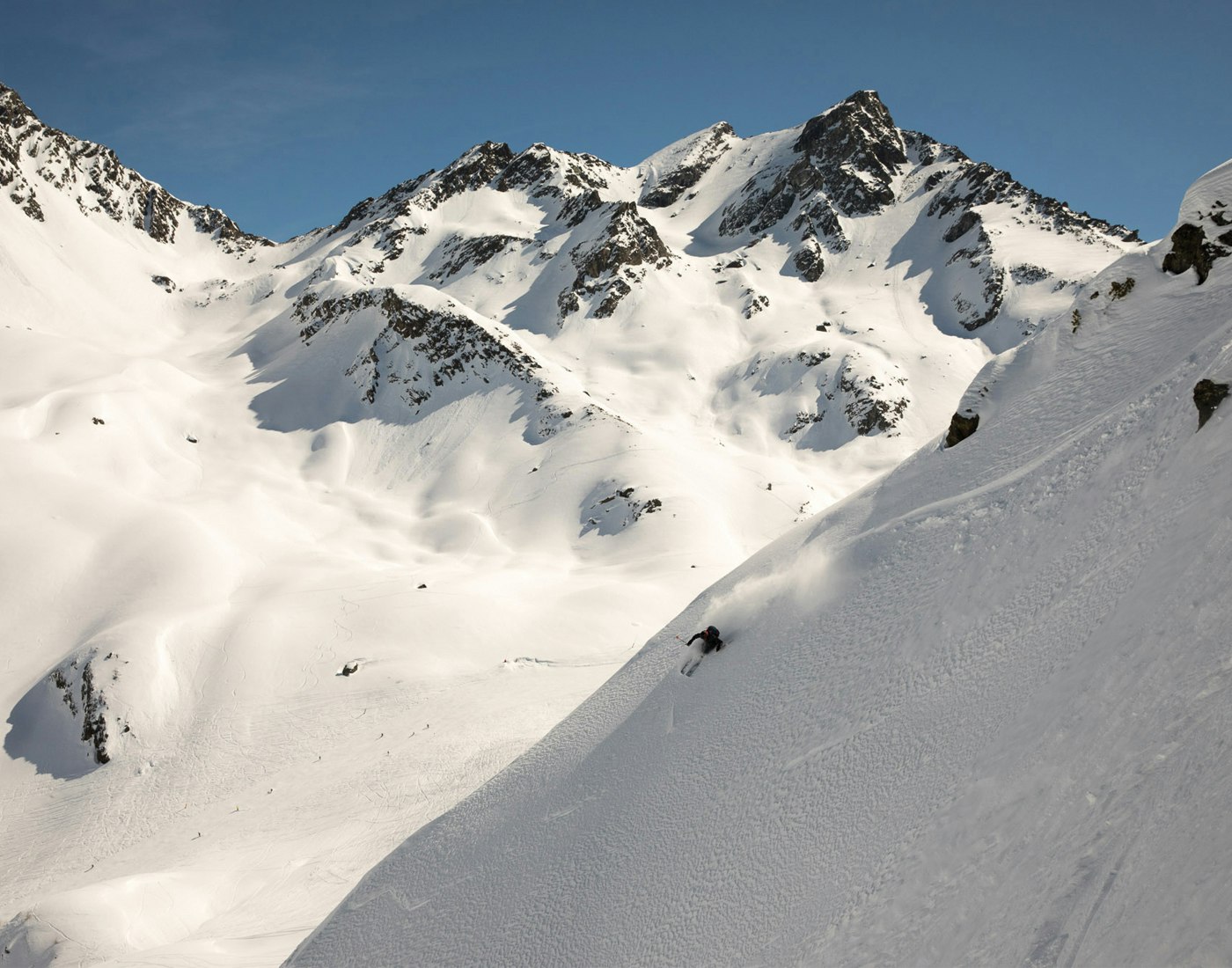
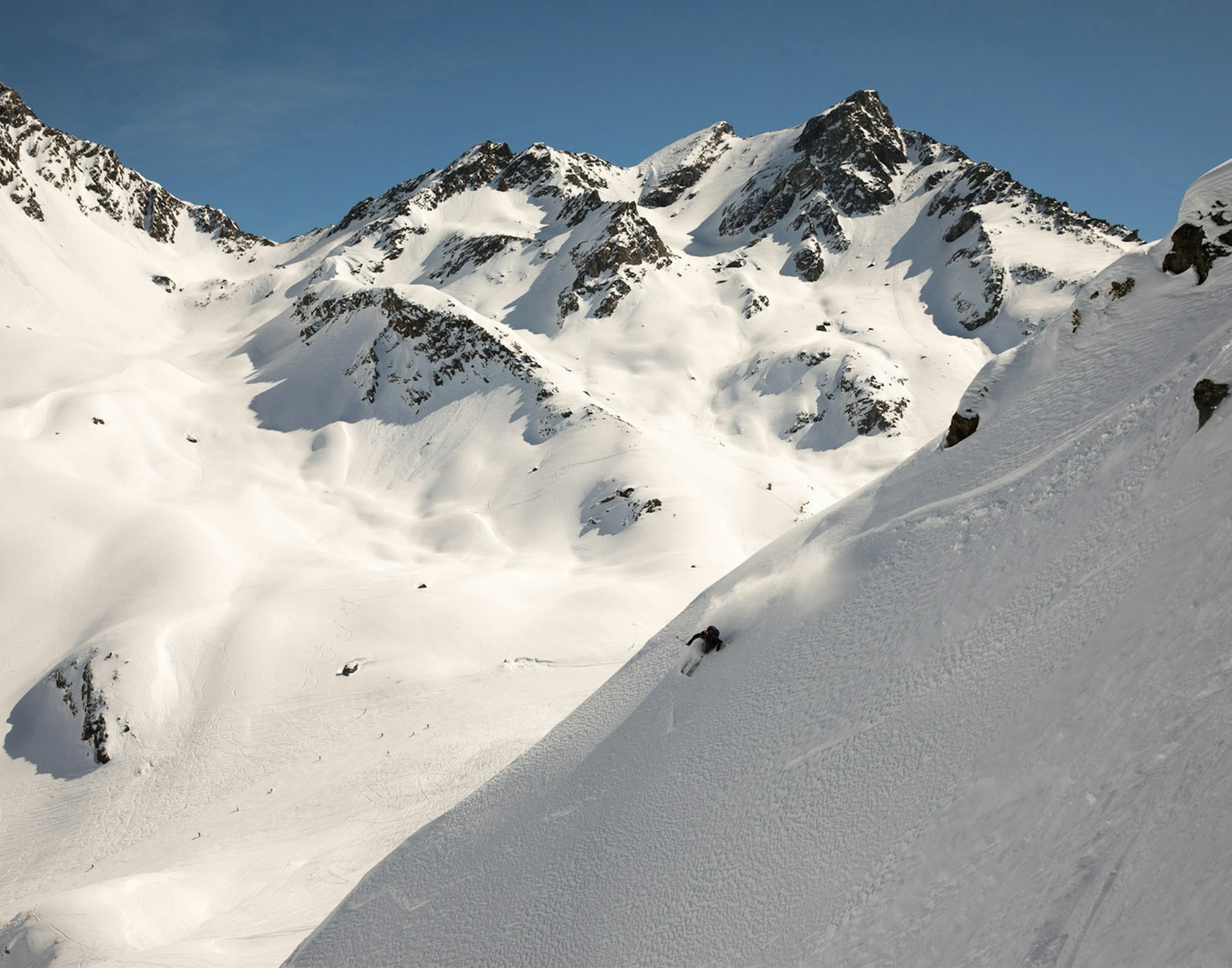
SKIER: Donny O’Neill | PHOTO: Ethan Stone
Our energy drained from the sunshine and merry-go-round of chute-skiing, we didn’t push the limits of the party scene in the evenings. But Ischgl certainly lived up to its slogan, “Relax. If you can.” In contrast to the tranquil sights and sounds of the daytime, the sunset brought on a transformation with thumping bass and flashing neon lights, along with general debauchery occurring in our periphery as we navigated the cobblestone streets in search of schnitzel. We couldn’t imbibe too much; our final-day objective was a long ski tour to one of Robert’s secret spots, and we didn’t want to disappoint him. For me, it was also the opportunity to ski in the true fashion of the Alps, utilizing the incredible transportation infrastructure to move great distances on skis. And with Robert showing us the way, our guide who had revealed himself as a beacon of the purity of Austrian alpinism, it was sure to be a hell of a tour.
We ascended the gondola, then up one lift and down the piste to another. Up and down again into Switzerland, then up and down again. After four lift rides we shed layers, attached skins and walked west along the Austrian-Swiss border. We shuffled uphill for half-a-mile then succumbed to gravity down an easy slope wearing a dust-on-crust coat of fresh snow, and then we walked again, past a frozen alpine lake and up, up, up through a notch at 2,700 meters. We snacked on chocolate and hydrated, gazing out over the expanse of white scales making up the spine of the Alps, embracing our minuscule standing amongst them.
Robert made sure to set expectations, letting us know we had one more descent, followed by another 300-meter climb before we’d arrive at his secret powder grotto. Watching the ease with which Robert’s strides moved him up the mountains, the way he looked at the uplifted slabs of rocks like they were his lovers, his ability to navigate like he’d been this way hundreds of times before, it was obvious that he was part of the very fiber of this region.
“It wasn’t until our touring day that [Robert’s] personality and story came alive,” remembered Smaine. “He and his wife live in a small chalet in a tight little valley near Ischgl, and he’s just completely enamored by the mountains. He spends almost every day, whether winter or summer, hiking, skiing and exploring every nook and cranny of the expansive peaks; he was so knowledgeable about every ridge and slope, both within and out of sight.”
Our excitement made the final push fly by, and we soon arrived at the place that put a smile on the face of our stoic leader. We crisscrossed the slope, switchbacking to our journey’s apogee. From the peak, Robert went through the entirety of the compass, pointing southeast to the Italian Dolomites, southwest into Switzerland, due west into the tiny country of Liechtenstein, north into Germany and east towards Innsbruck. From this sacred spot we gazed out at mountains that spanned five countries, a visual reinforcement of the interconnectedness of the European Alps.
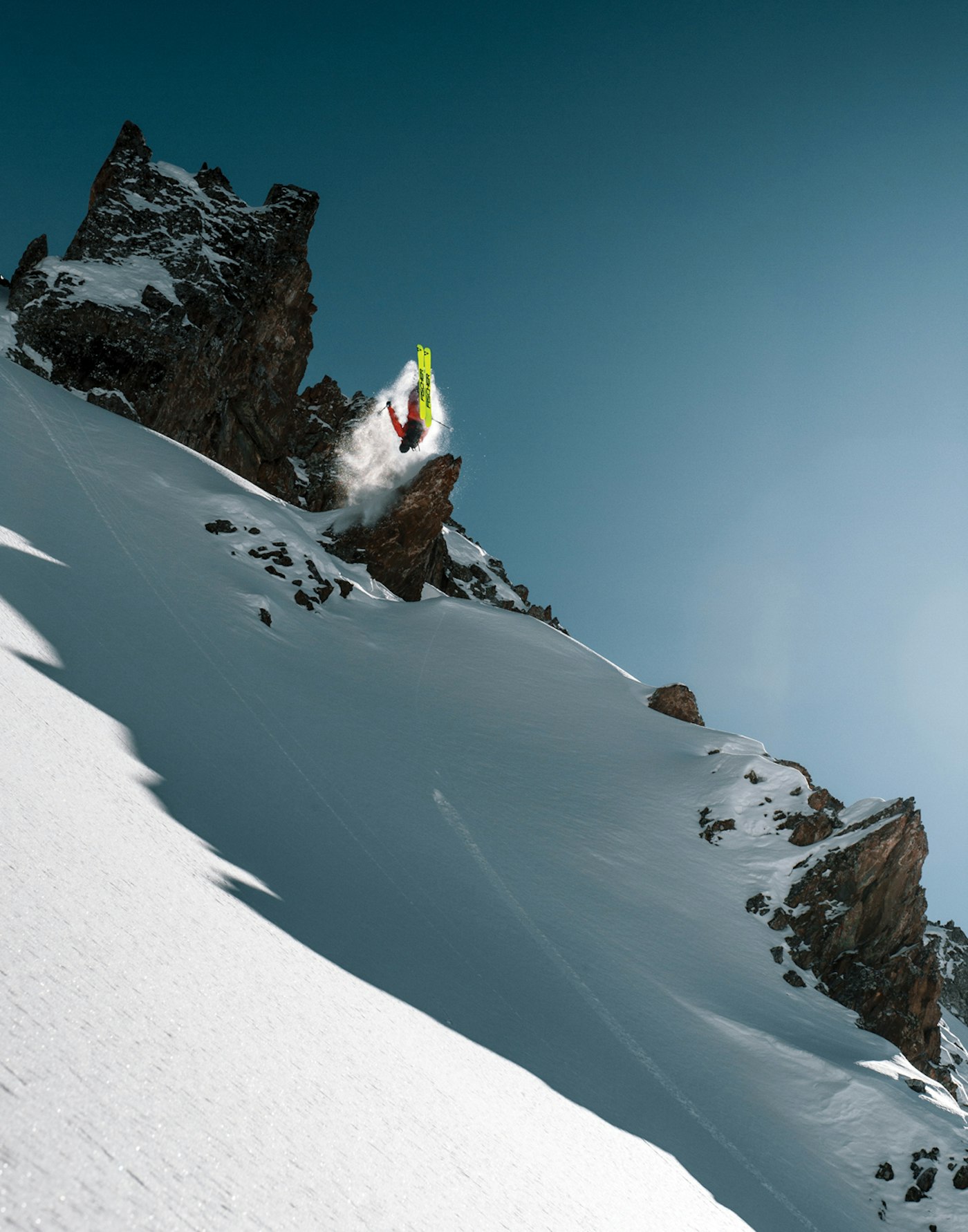
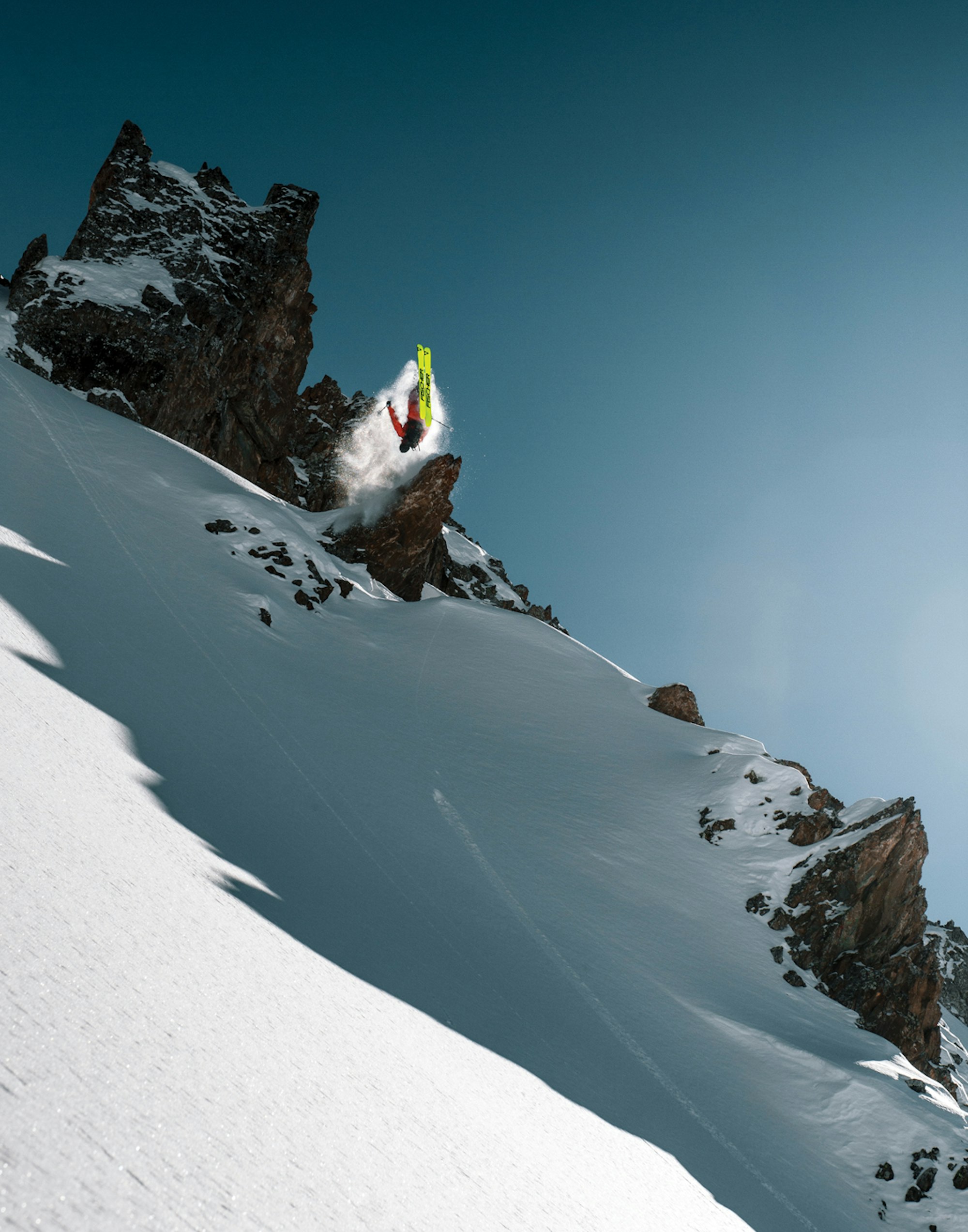
SKIER: KC Deane | PHOTO: Adam Klingeteg
Robert’s hideout lived up to his hype and was definitely worth the march to get there. Below us was a north-facing oasis of completely shadowed snow that went down like fresh water on a parched tongue after an extended stay in the desert. The dark slope extended for hundreds of meters before finding sunlight again and diving into the trees. Our descent took almost an hour, first through sensual knee-high powder, then perfect creamed corn and into slush hugging the trees, before we emerged next to a pairing of abandoned farmhouses above the road. Robert led us down to the highway, where, in front of us, was the bus stop. This guy was like the Magellan of ski guides. We crossed the street, skis over our shoulders, and within five minutes, caught the bus from Nederle back into Ischgl.
“The Alps are an endless oxymoron in the sense that when you are up in the mountains it looks like this endless expanse of massive peaks, yet in reality most things are relatively close together with a much better transportation infrastructure than the United States,” said Smaine. “We spent all day traversing the mountains, crossing back and forth between Austria and Switzerland, then skied right up to a bus stop and were dropped off right next to our hotel. It’s a vortex that will either overwhelm or open itself up to endless adventure opportunities.”
We said goodbye to Robert, who was looking forward to getting back into some of his secret lines on his day off the next morning, then retreated to the Hotel Ischgl to gather our belongings and be on our way. It’s an enlightening experience when you pull back the curtain and look beyond the surface level production. Ischgl’s a party-hard ski resort, that’s for sure, but when you dig a little deeper, the true character of the residents and the mountains reveal themselves in splendid fashion.
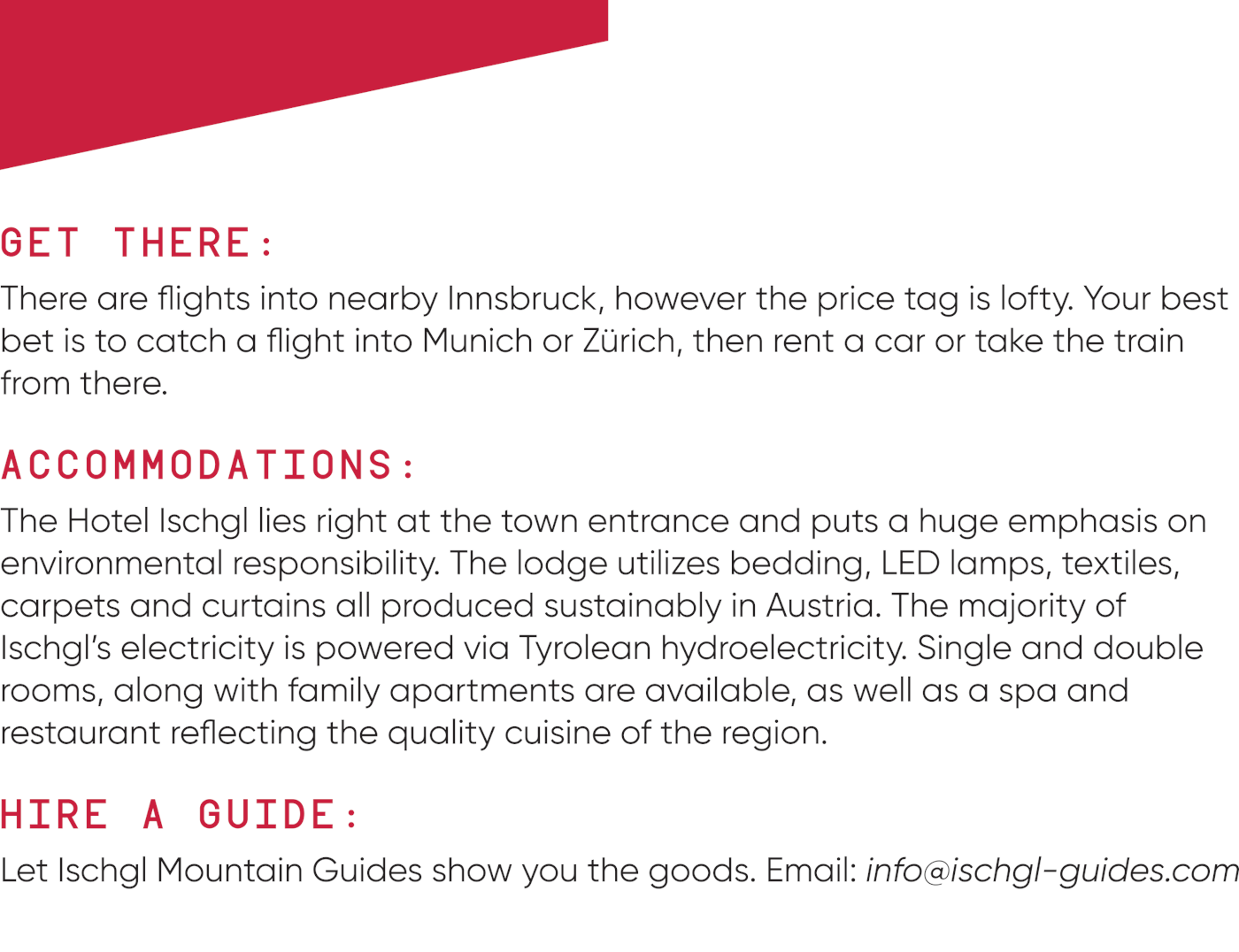
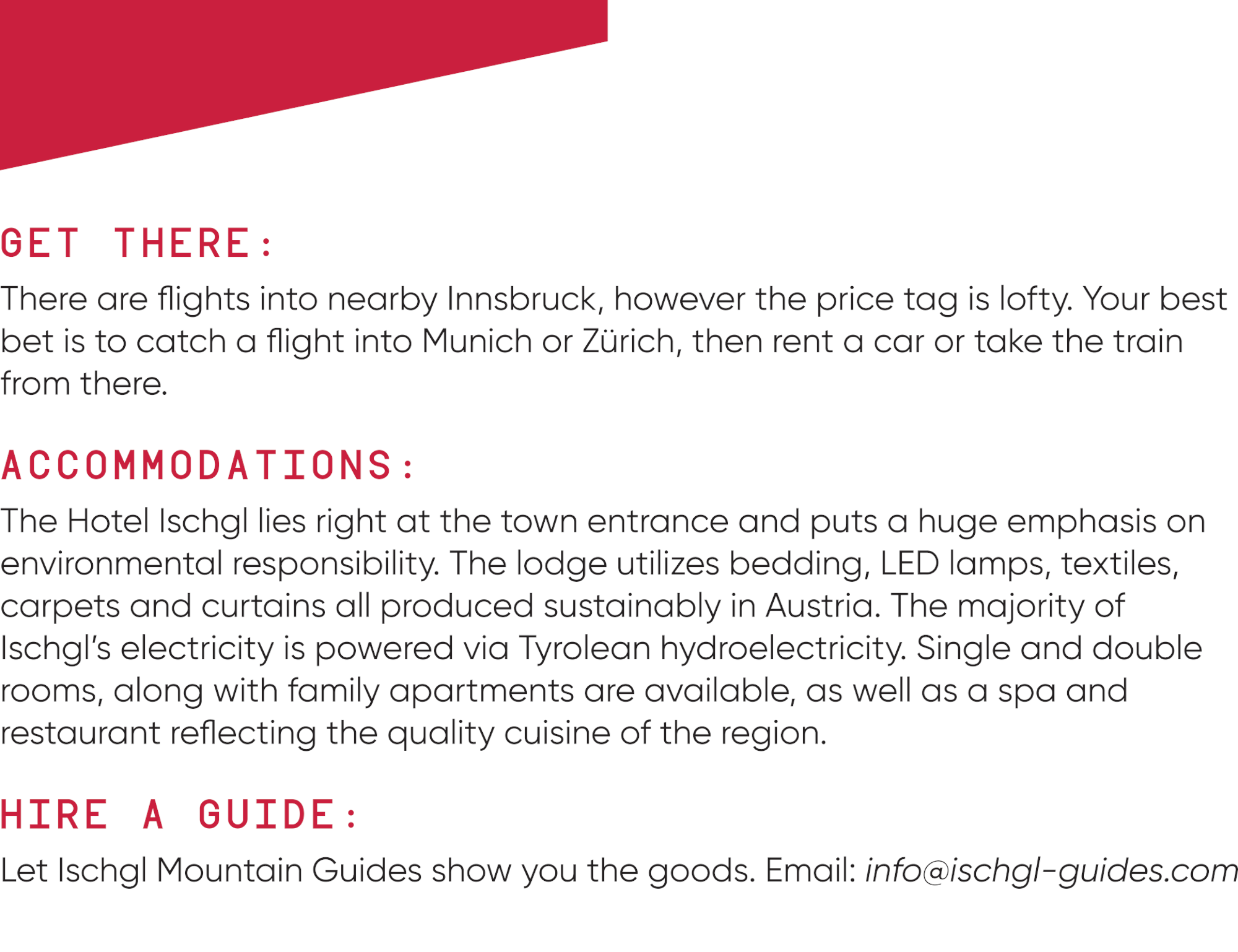


![[GIVEAWAY] Win a Legendary Ski Trip with Icelantic's Road to the Rocks](https://www.datocms-assets.com/163516/1765233064-r2r26_freeskier_leaderboard1.jpg?w=200&h=200&fit=crop)
![[GIVEAWAY] Win a Head-to-Toe Ski Setup from IFSA](https://www.datocms-assets.com/163516/1765920344-ifsa.jpg?w=200&h=200&fit=crop)
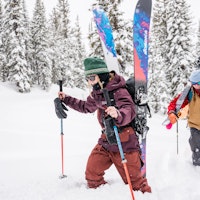
![[GIVEAWAY] Win a YoColorado X Coors Banquet Prize Package](https://www.datocms-assets.com/163516/1764877349-long-live-local-cooler-bag2.jpeg?w=200&h=200&fit=crop)
![[GIVEAWAY] Win a Legendary Ski Trip with Icelantic's Road to the Rocks](https://www.datocms-assets.com/163516/1765233064-r2r26_freeskier_leaderboard1.jpg?auto=format&w=400&h=300&fit=crop&crop=faces,entropy)


![[GIVEAWAY] Win a Head-to-Toe Ski Setup from IFSA](https://www.datocms-assets.com/163516/1765920344-ifsa.jpg?auto=format&w=400&h=300&fit=crop&crop=faces,entropy)


